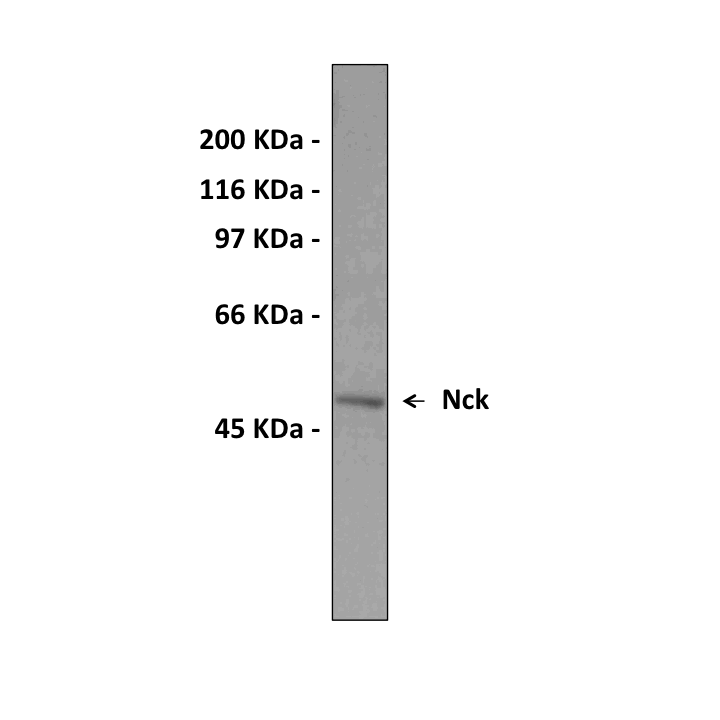Anti-Nck: Rabbit Nck Antibody |
 |
BACKGROUND A group of SH2- and SH3-containing proteins is composed exclusively of the SH domains and does not have any other enzymatic or known functional motifs. These proteins are therefore called SH domain-containing adapters. This group of proteins includes Crk (Crk-II and Crk-L), Grb2 (Sem-5Ash/Dor), Gads/Grap2/Grf40/GrpL/Mona/GRID, Nck (Nckalpha/Nck/Nck1 and Nckbeta/Grb4/Nck-2), Grb10, SLAP and Grap. The mechanism of action by these adapters is to link cell surface receptors, via their SH2 domains, to downstream effectors, through their SH3 domains. Different adapter proteins appear to connect either common or distinct surface receptors to different downstream pathways.1
Nck has, from its N-terminus, three consecutive SH3 domains, followed by a SH2 domain at the C-terminus of protein. There are two Nck isoforms (NCK alpha and beta) discovered in both human and mice. Nckalpha and Nckbeta in both humans and mice shared only 68% amino acid identity. In contrast, a comparison of mouse Nckalpha with human Nckalpha and a comparison of mouse Nckbeta with human Nckbeta showed over 95% amino acid identity. Nckalpha and Nckbeta are expressed in the same cells and are functionally redundant during development. On the other hand, individual Nck can play specific roles in various cell types and appear to have distinct signaling specificity.2
Nck has no known catalytic function and was shown to be a substrate for tyrosine kinase receptors. It binds and recruits various proteins involved in the regulation of receptor protein tyrosine kinases. It associates with tyrosine-phosphorylated growth factor receptors or their cellular substrates. Studies show that Nck plays a role in cell mitogenesis and morphogenesis. The former uses Ras-dependent and Ras-independent pathways. The latter appears to coordinate with the Cdc42/Rac>PAK1/WASp>actin cytoskeleton pathway. Crosstalk between these two pathways and engagement with other parallel pathways would determine the fate of a cell, such as division, migration and differentiation. The major role of Nck in regulation of cell to link cell surface receptors to the actin cytoskeleton. The fact that the majority of the more than 20 Nck-SH3-associated effectors are regulators of the actin cytoskeleton suggests that Nck regulates, via binding to distinct effectors, various cell type-specific motogenic responses.3 In addition. It was show that Nck maintains low levels of eIF2alpha phosphorylation by promoting its dephosphorylation by PP1.4 In this manner, Nck modulates translation and eIF2alpha signaling in response to ER stress.
REFERENCES
1. Buday, L. et al: Cell Signal. 14:723-31, 2002
2. McCarty, J.H.: bioessays 20:913-21, 1998
3. Li, W. et al: Oncogene 20:6403-17, 2001
4. Latreille, M & Larose, L.: J. Biol. Chem. 281:26633-44, 2006
2. McCarty, J.H.: bioessays 20:913-21, 1998
3. Li, W. et al: Oncogene 20:6403-17, 2001
4. Latreille, M & Larose, L.: J. Biol. Chem. 281:26633-44, 2006
Products are for research use only. They are not intended for human, animal, or diagnostic applications.
Параметры
Contact us regarding this antibody
Cat.No.: | CG1339 |
Antigen: | Purified GST fusion protein produced in E. coli., corresponding to human Nck amino acid sequence 1 to 254. |
Isotype: | Rabbit IgG |
Species & predicted species cross- reactivity ( ): | Human, Rat, Mouse |
Applications & Suggested starting dilutions:* | WB 0.1µg/ml IP n/d IHC n/d ICC n/d FACS n/d |
Predicted Molecular Weight of protein: | 42 kDa |
Specificity/Sensitivity: | Detects endogenous Nck proteins without cross-reactivity with other family members. |
Storage: | Store at -20°C, 4°C for frequent use. Avoid repeated freeze-thaw cycles. |
*Optimal working dilutions must be determined by end user.
Документы
Информация представлена исключительно в ознакомительных целях и ни при каких условиях не является публичной офертой








